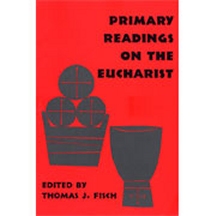
|
Posted December 14, 2004
Book: Primary Readings on the Eucharist Edited by Thomas J. Fisch Liturgical Press, Collegeville, MN, pp257 An Excerpt from the Jacket:
The chapters give evidence of increasing theological convergence in the thinking of contemporary Eastern and Western theologians on the Eucharist. This consensus is the result of developments in biblical studies, our increasing knowledge of the Fathers, and the findings of liturgical studies and the historical study of the Church’s liturgy in the East and the West. An Excerpt from the Book: In the early Christian Church the celebration of the Eucharist implied a meal, an obvious activity since Jesus had instituted the Eucharist within the context of a Jewish Passover meal. In his first letter to the Corinthians (1 Cor 11:17-34) written in 55 A.D., the apostle Paul assumes this tradition and, with his disciple Luke, gives the most ancient description of the eucharistic meal. Central to it was the command given by Jesus: “Do this in memory of Me” or the pronouncement of the eucharistic blessing, transforming the bread and wine into signs of Christ and his saving act, followed by the eating of the bread and the drinking of the wine. This act of eating and drinking was an “active” form of participation, and “entry into the paschal mystery of the Lord.” Over the centuries attention shifted increasingly from the activities surrounding the bread and wine within the Lord’s supper to reverence for the bread and wine themselves. Up to the tenth century this was still within the context of the Mass but subsequently was placed more and more outside its liturgical setting. This gradual uncoupling of the eucharistic gifts from their sacramental and liturgical context, the community celebration of the meal, is sometimes referred to as the process in which the Eucharist became “independent” or “disengaged.” The seeds of this “process of independence” can be found in the early shift from community meal or “agape” to the ritual consumption of his body and blood alone. It was practically an automatic process whereby the emphasis came to be placed more on Christ’s presence as food for the soul and less on his eschatological presence in the community nature of the ritual, which was centered on praise of God, repentance and forgiveness. Within this process of limitation, from real to merely sacramental meal — a phenomenon already apparent in apostolic times — the taking of the Eucharist t those prevented from being present at the ritual was a logical step. In this way they too were enabled to share in Jesus by receiving the food over which the community prayer of thanksgiving had been uttered. Justinus Martyr mentions this custom in his Apologia written around A.D. 150. Following logically from this development, and helped partly by the persecutions, it became the custom to preserve and received the Eucharist at home during the week. Home communion as celebrated in early Christian times persisted until the seventh century, although it was less common from the fourth century onwards. Despite this tendency towards privatization, the Church remained attached to the link with the community celebration, something clearly seen in the practice of the fermentum, a piece of the eucharistic bread which, around the year 400, the pope caused to be sent to the other titular churches of Rome as a symbol of unity with his celebration. The customs of the fermentum and home communion during ancient Christian times show that the presence of Christ in the eucharistic bread was not a source of awe at the time. The Eucharist was seen primarily as the anamnesis — remembrance – which made actual Christ’s work of salvation. Table of Contents: 1. Israel’s Theology of Memory Brevard S. Childs 2. Toward a Theology of the Christian Feast Robert F. Taft, S.J. 3. The Development of the Private Mass Cyrille Vogel (William G. Storey, Niels Krogh Rasmussen, translators) 4. The Process of Independence of the Eucharist Godefridus J. C. Snoek 5. The Dogma of the Council of Trent on Transubstantiation: Its Development and the Categories in Which It Is Expressed Edward Schillebeeckx, O.P. 6. Cranmer and the Anglican Eucharist Louis Bouyer 7. The Roman Canon: The Theological Significance of Its Structure and Syntax Dominic E. Serra 8. Ex Oriente Lux? Some Reflections on Eucharistic Concelebration Robert F. Taft, S.J. 9. Receiving Communion: A Forgotten Symbol Robert F. Taft, S.J. 10. Communion and Intercommunion Bishop Kallistos (Ware) of Diokleia 11. Eucharist and Catholicity John Zizioulas |
|
